Team EduHealth recently surveyed school nurses to understand the latest EHR (Electronic Health Record) adoption trends in schools and school districts.
The statistical report is based on a survey we conducted, which finds what in an EHR are school nurses and administrators looking for and which features in the system improved its adoption rates in the school and school districts. We’ve also covered important statistics on the other key decision-making factors in EHR adoption.
The respondents of the survey are school nurses from schools and school districts in sMid-West, South-East and North-East America.
Background
Until very recently, school nurses used paper records to manage student health. The traditional methods of paper-based health record management were proving to be tedious and an administrative burden on already overworked school nurses.
If a student came to the nurse’s room with an emergency health condition, the school nurse would have to open up hundreds of documents to learn more about the student’s pre-existing health conditions, allergies and the right medication. There also was the glaring disproportion of school nurses with students, which made things harder.
In this context, health record software that electronically recorded student medical records were seen as a practical alternative to make school nurses’ jobs a tad bit easier.
But as COVID 19 began its onslaught, electronic health record systems – whose capabilities then predominantly included medication tracking and immunization tracking had to be pivoted to include COVID 19 tracking and the ability to track student health remotely. COVID 19 also prompted several schools to quickly adopt an electronic health record system to meet the changes presented by the “new normal.”
Today, though most schools have a system to track health records, expectations around what can be achieved with these systems have changed. But, there is no denying that EHR systems for schools have revolutionized student care by making it easy for school nurses to track and stay on top of student health without being riddled with loads of administrative tasks.
And as EHR adoption rates grow, we aim to understand how school nurses use EHR systems and the critical features in an EHR system used most by school nurses and administrators to manage student health documents as well as the objective they hope to fulfill with EHR systems.
The EHR statistics results are based on the information given to us by over 100 school nurses.
Key takeaways of the survey
- 91% school nurses use some form electronic system to manage health records in their schools
- 30% schools do not have a COVID 19 tracking and contact tracing system in place
- Immunization tracking and charting capabilities in an electronic health record are very important to school nurses
- User friendliness is an important electronic health record adoption feature, with 86% of respondents replying in the positive
- Reporting capabilities is also a major priority, with 86% responding as very important
- Most school nurses want their student electronic health record systems to be HIPAA and FERPA compliant
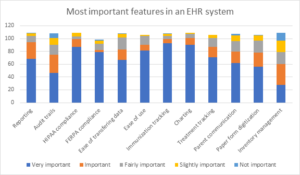
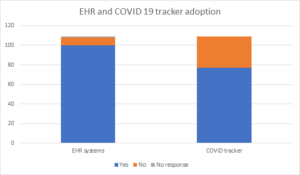
EHR systems in a school environment
“EHR systems in a school setting have the capability to manage data and share it with members of the health care team outside the school setting can serve to optimize coordination of care.” NASN
Schools have adopted EHR to simplify the management of important health information and make it easily accessible. In our survey, we asked the respondents if they used EHR systems. And 91% of the respondents said they use electronic health record systems in their schools. EHRs are essential to simplify the management of student health and medication needs.
Electronic health record (EHR) is an electronic version of a patient’s medical history maintained over time. It includes all the critical administrative clinical data relevant to the person, including medications, problems, immunizations, other health notes, and so on. EHR systems automate information and have the potential to streamline their user’s workflow.
However, from our survey, we gathered that 9% of survey respondents still rely on traditional methods, including paper forms or excel sheets, to manage student health record management.
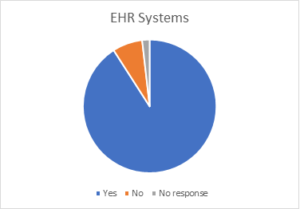
What do 91% of school nurses expect from an EHR system?
Though the EHR statistics says that 91% of school nurses have adopted an EHR platform, there are a significant number of users who are not happy with what the platform offers. As the complexity of health reports changes, school nurses and administrators need a system that can adapt to changing expectations.
So, what are they looking for in an EHR system?
Let’s find out.
EHRs must be simple
User friendly interfaces
When asked about the user friendliness of EHR systems, 86% of respondents in the EHR survey said the feature was a “very important” one. When school nurses use an electronic health record system, they expect ease of use, which takes only a reasonable amount of time to learn.
EHR usability is defined by the effectiveness, efficiency, and satisfaction with which specific users can achieve a particular set of tasks for a specific environment. Poor educational EHR usability leads to school nurses’ burn-out, increased medication errors, and student safety issues.
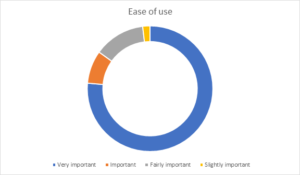
Health record and form digitization capabilities
73% of EHR survey respondents say that health record and paper form digitization capabilities “on-the-go” is a crucial priority.
Though EHR systems store information digitally, the process of entering data remains largely manual. The data entry process involves several hours’ worth of effort. School nurses usually manage multiple health-related administrative tasks in the school, and one among them is updating students’ health records.
While they earlier resorted to documenting them on paper records, the system was not reliable because human error loomed largely. Modern EHR systems leverage several technologies to help the school nurse community overcome this challenge. But sometimes, these systems make it difficult for school nurses to capture and store data in the right locations.
The bulk scanner on EduHealth focuses on helping school nurses overcome this critical challenge. It scans the relevant information from health forms and saves it in the system. This way, it saves several administrative work hours and ensures all the data is stored in the right format, making data reporting- and audit-ready anytime.
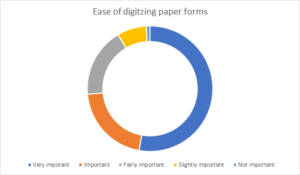
Data transferability and uniformity
The right data is very critical to arrive at the right conclusions. But transferring data from an existing system to another one is a challenge. First, all the data would be siloed and secondly, they’d be stored in multiple formats – some digital and some in paper.
In this scenario, it can be difficult to transfer data to a system, let alone make sense of it.
62% of EHR survey respondents consider ease of transferring data a “very important” aspect of an EHR system and a key aspect in EHR adoption decisions. 17% say it’s “fairly important.”
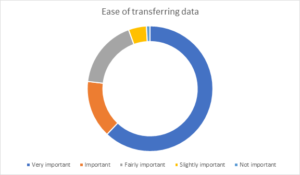
Tracking and information management
Tracking immunizations and vaccination compliance
Immunization tracking is one of the primary objectives of an EHR system. 86% of school nurses have said it is “very important” for them to have the immunization tracking feature.
Immunization tracking makes it easy to identify students who’ve missed/delayed a vaccination. And with EHR systems, reporting vaccination compliance to local health departments is easy.
In a typical scenario, the immunization details of a student are not consolidated in one facility. This makes it difficult for health officials to know who’s received the vaccine and who’s not. School nurses would have to spend hours identifying students who have missed a specific vaccination dose, perusing through paper records and documents to identify misses.
Electronic health record software eliminates such challenges, making it easy to identify students who’ve missed a dose of vaccination in a few simple clicks. EHR systems can generate alerts and decrease instances of missed opportunities for vaccination.

Ability to track medications and treatments
Relying on handwritten instructions when administering medication to students can have dire consequences. An accurate medication tracking system is essential in schools. An EHR system with MAR (medication administration record) helps school nurses create a log of medications administered to students.
A majority of our respondents have backed up this premise. 74% of respondents say treatment tracking is a “very important” feature in the EHR system.
EHR systems should document when medications are given to students and staff, ensure that medication administration rules are followed – right patient, right drug, right dose, right time, and right route.
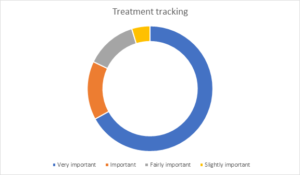
Log of actions taken and treatments administered
75% of respondents say that documentary evidence of who accessed an electronic medical record system, when they accessed it, from where and exactly what they did is important to them.
EHR audit log data is to be HIPAA compliant, making it able to audit inappropriate access to protected health information. Audit trails in student EHRs provide visibility to authorized users such as the school nurse, creating a system to review historical security and operational activity accurately.
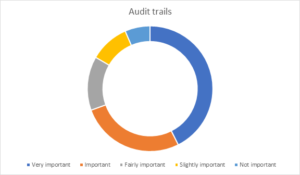
Charting capabilities
Charting is the focal point of student healthcare, and school nurses have responded that it is a critical feature – an EHR system must-have. 82% have responded as “very important”.
Charting lets school nurses have a documented medical record of medications, doctor visits and more of a student. School nurses get a quick view of their students’ health information. All the essential clinical data is consolidated on one platform helping school nurses be ready with the right health information at all times.
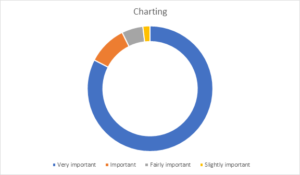
COVID 19 tracking and contact tracing
70% of respondents say they already have COVID-19 tracking systems in place in their schools.
Digital health organizations have released a slew of tools to monitor and contain the spread of COVID-19 in schools as children return to schools across the country. While most tracking systems are independent software, some systems have a tracking mechanism built-in on their educational healthcare software used in the school.
However, it’s not enough to have a tracking system in place. Some electronic health records for schools have a contact tracing facility to identify close contacts of an infected person and make communications quick and efficient.

Reporting
Schools must comply with local and state health authorities’ reporting requirements. Reporting is essential to identify health trends prevailing among students, the schooling environment and any specific recurring health issues that need the special attention of health authorities.
An electronic health record with reporting capabilities the task of collecting the right data easy for school nurses. As schools need to submit reports to the school district, county, state and other important healthcare bodies, a system to generate reports within the electronic health record system becomes crucial.
86% of respondents have therefore said that reporting is an essential feature in an EHR system.
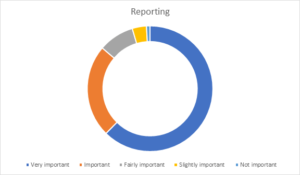
Compliances
HIPAA compliance
The Health Insurance Portability and Accountability Act (HIPAA) sets the ground rules for sensitive patient data protection. Schools that work with protected health information (PHI) and transacts them electronically must be HIPAA covered.
Of all the respondents, 90% find HIPAA compliance a critical factor in the EHR system.
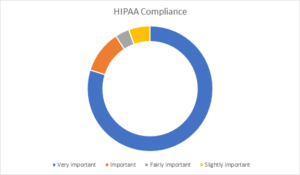
FERPA compliance
Family Educational Rights and Privacy Act (FERPA) applies to all educational institutions that receive direct funding through the Department of Education programs.
Students’ health records, which also include information on immunizations and records maintained by the school nurse, are considered part of the student’s education record and are protected from disclosure under FERPA.
84% of respondents say FERPA compliance is essential to them.
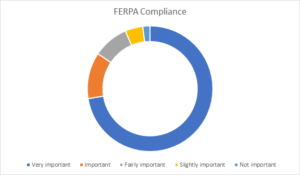
Supportive framework
Communication with parents
A majority of school nurses find interaction with parents integral to improving student health. 74% of school nurses feel communication with parents is essential to keeping children healthy and safe.
Therefore, a mechanism to communicate with them through EHR system could be a good idea. School nurses can get help from parents in emergency cases to take the right calls for student health.
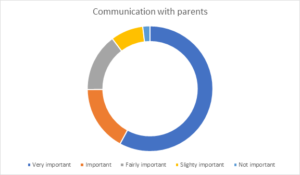
Conclusion
2020 is the year that has pushed major sectors to adopt technological solutions to get their activities moving. And the same stands for the education as well. While classes moved to online models, student healthcare had to follow suite.
Though electronic health record systems had already made headway into schooling environments much before, 2020 became a year that propelled its adoption.
Several schools have adopted some model of an EHR system, but there is much that is to be done to improve their user experience and functionality. School nurses agree with this as many of them have concerns surrounding the solutions they are using today. These changing expectations put pressure on electronic healthcare solution providers to work on their systems to meet user expectations.








